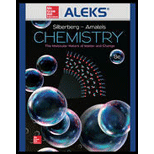
(a)
Interpretation:
The full ground state electronic configuration of
Concept introduction:
The electronic configuration of an element tells about the distribution of electrons in the atomic orbitals. The energy level that has lower energy is considered to be the ground state. Due to its lower energy, the ground state is taken as a stable state.
The electronic configuration shows the distribution of electrons of atoms in the atomic orbitals. It is used to predict the physical, chemical, electrical and magnetic properties of the substance.
The electrons are filled up in accordance with three rules:
1. Aufbau principle which states that the electrons are filled up in the increasing order of their orbitals which follows as:
2. Hund’s rule which states that the pairing of electrons will not start until each of the orbitals is singly occupied.
3. Pauli’s exclusion principle states that no two electrons can have the same value of all the four quantum numbers.
(b)
Interpretation:
The full ground state electronic configuration of
Concept introduction:
The electronic configuration of an element tells about the distribution of electrons in the atomic orbitals. The energy level that has lower energy is considered to be the ground state. Due to its lower energy, the ground state is taken as a stable state.
The electronic configuration shows the distribution of electrons of atoms in the atomic orbitals. It is used to predict the physical, chemical, electrical and magnetic properties of the substance.
The electrons are filled up in accordance with three rules:
1. Aufbau principle which states that the electrons are filled up in the increasing order of their orbitals which follows as:
2. Hund’s rule which states that the pairing of electrons will not start until each of the orbitals is singly occupied.
3. Pauli’s exclusion principle states that no two electrons can have the same value of all the four quantum numbers.
(c)
Interpretation:
The full ground state electronic configuration
Concept introduction:
The electronic configuration of an element tells about the distribution of electrons in the atomic orbitals. The energy level that has lower energy is considered to be the ground state. Due to its lower energy, the ground state is taken as a stable state.
The electronic configuration shows the distribution of electrons of atoms in the atomic orbitals. It is used to predict the physical, chemical, electrical and magnetic properties of the substance.
The electrons are filled up in accordance with three rules:
1. Aufbau principle which states that the electrons are filled up in the increasing order of their orbitals which follows as:
2. Hund’s rule which states that the pairing of electrons will not start until each of the orbitals is singly occupied.
3. Pauli’s exclusion principle states that no two electrons can have the same value of all the four quantum numbers.
Want to see the full answer?
Check out a sample textbook solution
Chapter 8 Solutions
CHEMISTRY:MOLECULAR NATURE...-ALEKS 360
- What is surface excess according to the Gibbs model?arrow_forwardUsing Benzene as starting materid show how each of the Following molecules Contel Ve syntheswed CHI 9. b -50311 с CHY 503H Ночто d. อ •NOV e 11-0-650 NO2arrow_forwardThe molecule PYRIDINE, 6th electrons and is therefore aromatre and is Assigned the Following structure contering Since aromatk moleculoy undergo electrophilic anomatic substitution, Pyridine shodd undergo The Following reaction + HNO3 12504 a. write all of the possible Mononitration Products that could Result From this reaction 18. Bared upon the reaction mechanison determime which of these producty would be the major Product of the hegetionarrow_forward
- a. Explain Why electron withdrawing groups tend to be meta-Directors. Your answer Should lyclude all apropriate. Resonance contributing Structures fo. Explain why -ll is an outho -tura drccton even though chlorine has a very High Electronegativityarrow_forward9. Write Me product as well as the reaction Mechanism For each of the Following Vanctions +H₂504 4.50+ T C. +212 Fellz 237 b. Praw the potential energy Diagrams For each OF Mese Rauctions and account For any differences that appear in the two potential Puergy Diagrams which of here two reactions 19 Found to be Reversable, Rationalice your answer based upon the venation mechanisms and the potential energy diagrams.arrow_forward9. Write Me product as well as the reaction Mechanism For each of the Following Veritious +H2504 4.50+ + 1/₂ Felly ◎+ 7 b. Praw he potential energy Diagrams For each OF Mese Ronctions and account for any differences that appeak in the two potential Puergy Diagramsarrow_forward
- Draw the major product of this reaction. Ignore inorganic byproducts. Incorrect, 3 attempts remaining 1. excess Br2, NaOH 2. neutralizing workup Qarrow_forwardGiven the electrode Pt | Ag | Ag+ (aq), describe it.arrow_forwardAt 25°C, the reaction Zn2+ + 2e ⇄ Zn has a normal equilibrium potential versus the saturated calomel electrode of -1.0048 V. Determine the normal equilibrium potential of Zn versus the hydrogen electrode.Data: The calomel electrode potential is E° = 0.2420 V versus the normal hydrogen electrode.arrow_forward
 ChemistryChemistryISBN:9781305957404Author:Steven S. Zumdahl, Susan A. Zumdahl, Donald J. DeCostePublisher:Cengage Learning
ChemistryChemistryISBN:9781305957404Author:Steven S. Zumdahl, Susan A. Zumdahl, Donald J. DeCostePublisher:Cengage Learning ChemistryChemistryISBN:9781259911156Author:Raymond Chang Dr., Jason Overby ProfessorPublisher:McGraw-Hill Education
ChemistryChemistryISBN:9781259911156Author:Raymond Chang Dr., Jason Overby ProfessorPublisher:McGraw-Hill Education Principles of Instrumental AnalysisChemistryISBN:9781305577213Author:Douglas A. Skoog, F. James Holler, Stanley R. CrouchPublisher:Cengage Learning
Principles of Instrumental AnalysisChemistryISBN:9781305577213Author:Douglas A. Skoog, F. James Holler, Stanley R. CrouchPublisher:Cengage Learning Organic ChemistryChemistryISBN:9780078021558Author:Janice Gorzynski Smith Dr.Publisher:McGraw-Hill Education
Organic ChemistryChemistryISBN:9780078021558Author:Janice Gorzynski Smith Dr.Publisher:McGraw-Hill Education Chemistry: Principles and ReactionsChemistryISBN:9781305079373Author:William L. Masterton, Cecile N. HurleyPublisher:Cengage Learning
Chemistry: Principles and ReactionsChemistryISBN:9781305079373Author:William L. Masterton, Cecile N. HurleyPublisher:Cengage Learning Elementary Principles of Chemical Processes, Bind...ChemistryISBN:9781118431221Author:Richard M. Felder, Ronald W. Rousseau, Lisa G. BullardPublisher:WILEY
Elementary Principles of Chemical Processes, Bind...ChemistryISBN:9781118431221Author:Richard M. Felder, Ronald W. Rousseau, Lisa G. BullardPublisher:WILEY





